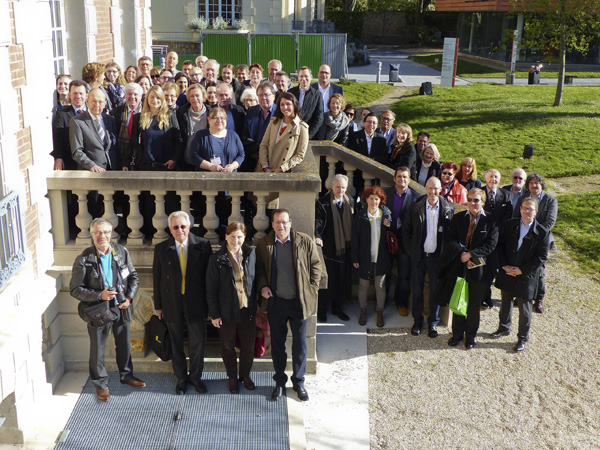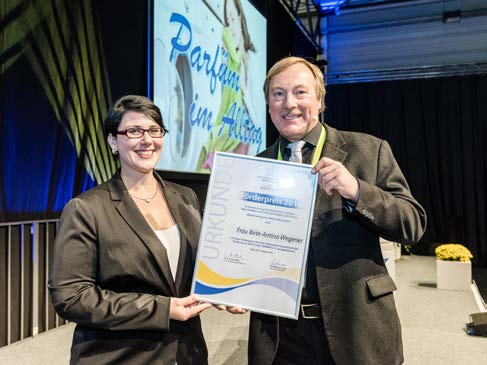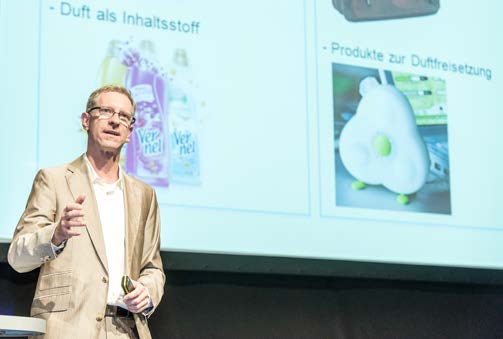DGP Annual Report 2016
The German Society of Perfumers (DGP) has continued the scientific and networking programme in 2016 with various activities around the beauty of scents and their emotional esthetics.
Spring conference Paris, April 28 – 29, 2016
The annual spring meeting of the German Society of Perfumers was held in Paris, offering the attendees an interesting programme of presentations and tours.
Under the direction of Dr. Klaus Henning, the DGP board was newly elected. It consists for the next two years of Dr. Wolfgang Krause (President), Dr. Anneliese Wilsch-Irrgang (Vice President), Daniel Dillenséger (Budget Executive) and Dr. Edison Diaz (Board Secretary).
On the first day, Hervé Fretay (Givaudan) reported about the “Ethical Sourcing of Natural Resources Through Evolution, Innovation and Creation”. Natural ingredients from all around the world have always been used in perfumery. As the green consumer scale is very broad, there are many challenges to satisfy market needs: there are very different grades of natural fragrances, specific preferences of the product profile and requests for sustainable supply, considering ethical values and environmental protection. The dynamics of the production has changed rapidly over the last ten years. Supply has become more volatile due to speculation, crop availability is subject to the pressure of competition for land and the rural exodus and socio-economic factors and ethical sourcing have become a key element for success. Based on that, an ethical procurement at source guarantees the continuous supply in social interaction with highest quality standards. An example is the processing of Tonka beans in Venezuela, with the result of the preservation of the almond flavor associated with the coumarin tone and characteristics of chocolate and coffee aromas.
Sabine Chabbert (Fragrance Foundation France) talked about “The Culture and Future of Perfume. Our Main Responsibility Today”. Using more than 3,500 raw materials and years of creation experience, perfumers belong to the group of creative artists with a very high reputation. To surprise consumers, new avenues must be explored. The acceptance of cultural impacts, the promotion of cosmopolitan perfume styles and the cooperation between generations drives also the modern perfumery. Niche markets are decently growing, while setting some new trends for olfactory surprises and modern creations with spices, flavor notes and tailor-made products. In 2015, 2,000 new perfumes were launched globally, 950 were feminine, 350 masculine and 750 were gender-neutral.
Roland Salesse (INRA, Centre de Jouy-en-Josas, France) presented on the subject “Fragrance – from Neuroscience to the Stage”. Theatrical performances focus mainly on visual and acoustic Perceptions. Performances rarely entail contact or fragrance. In contrast, contemporary art breaks with these codes by means of total entertainment or multisensory presentations. Whereas light and sound reach a theater audience practically instantaneously, odorants only move at a speed of 1–5 m/s and may take 20 seconds to reach the middle of the room. And whereas visual information plays a dominant role for the human brain, fragrance does indeed have its own asset: it begins in the fetus and stores olfactory memories throughout life. As a form of chemical communication it plays a vital role in the survival of individuals and species. To incorporate scent into theatrical performances several methods have been applied. On one hand, one can rely on powerful atomization systems which disperse the scent in the whole auditorium. Here much care has to be taken to ensure a homogeneous scent delivery over space. Another solution is to dose small amounts of perfume from fixed systems of adsorbed perfume positioned as close as possible to the spectator’s nose. In a very refined set-up, the participants each have a “scent microphone” in their hands, which feeds fragrance mixtures through a Teflon pipe. This technology was chosen for the radical experiment “Green Aria: A Scent Opera”, which was invented by Stewart Matthew and Christophe Laudamiel and performed 2009 in the Guggenheim Museum New York and Bilbao. For this piece a special perfume organ which could play 33 odorants had been designed. The scent opera was played in pitch dark, with only music and perfumes. Spectators were surprised that they could “smell” the action, and many reported that they had discovered their smell sense here.
Ange Zola (Osmothèque Versailles) described the current situation of “Lavender – from Essential Oil to Perfume”. Lavender is widely cultivated and belongs to the group of very important plants for essential oils. The lavender plant is propagated by seed germination. Producers use the designation lavandula vera to distinguish it from lavandin which is also popular for use in fragrances and essential oils. As with wines, the fragrance notes obtained from the varieties (“lavender populations”) are strongly influenced by the area of cultivation, altitude and analytical indicators. Today, lavender is mainly produced in Bulgaria, Russia and China, France has lost the leading position due to cost constraints. Authentic lavender from Provence was the benchmark for many centuries and the first choice of perfumers and helped to create successful perfumes, e.g. “Fougère Royale” by Houbigant or Caron´s “Pour Un Homme”.
The second day of the spring meeting was a specific highlight for our inspiration: a visit to Versailles to see the famous Osmothèque. This world´s largest fragrance archive has a unique collection of 3,500 perfumes and compositions, going back to the early days of traditional perfumery centuries ago. Patricia de Nicolai, President of the Osmothèque, gave us an exciting overview of the history of perfumery from ancient days to modern times, challenging all our senses in a smell session with many famous perfumes and perfume types. After these great impressions, we also made a tour of the training facilities of the ISIPCA school located nearby.

The Promotion Award 2016 by the German Society of Perfumers, a programme to support junior scientists and scientific, was presented to Dr. Birte-Antina Wegner for her dissertation about “Smell training with elderly people”. Reduction in olfactory function affects the quality of life and enhances likelihood of depression. Also it has been shown that a reduction of the olfactory function correlates with cognitive impairment in Parkinsons disease. The aim of this study was to investigate whether the positive effects of smell training extend to subjective well-being and cognitive functions. 91 healthy participants (aged 50 to 85 years), randomly assigned to an olfactory training group. In a first appointment olfactory and cognitive function were tested as well as subjective well-being. The same testing was repeated after 5 months. A significant improvement of olfactory threshold and discrimination ability was found in the training group compared to the control group. Furthermore, participants of the training group improved in cognitive function, felt younger and more active after training. No such effects were observed in the control group. In a subgroup of participants characterized by subclinical depression at the first appointment, the olfactory training had a positive effect on the severity of depression. Based on these results, olfactory training seems to constitute an inexpensive and simple way to improve quality of life in elderly people.

SEPAWA annual conference Fulda, October 12 – 14, 2016
Topic of the DGP contribution to the SEPAWA conference 2016 was “Perfumery in everyday life” with an interactive session about the value chain ingredients – fragrance composition – final product for various product and scent types. In addition to that, the DGP meeting point offered participants the opportunity to learn more about these product types, from fine fragrances to home care and body care products. Experts of the DGP explained the specific scent characteristics and answered numerous questions.
The DGP afternoon session offered an in depth illustration of the value chain of fragranced consumer goods. At six thematic tables perfumery experts showcased typical scent varieties of everyday products, from important raw materials to the finished products.
How to compose an agreeable fragrance for a detergent that you can smell even on dry laundry? What is the meaning of Chypre as a typical fragrance for blue fabric softeners? What scent components emphasize caring features of a body lotion? In very animated conversations about 100 visitors got answers to these and many more questions.
Dr. Patrick Hehn (isi GmbH) explained in his speech during the DGP afternoon the “Power of Scents”. We all need to breathe and therefore cannot avoid smell. At the same time the perception of scents depends on many influencing factors, e.g. whether scents signal danger, address a current need or have an individual emotional meaning.
Scents that are perceived as pleasant have a huge influence on individual well-being and play a significant role in marketing. Dr. Hehn presented informative examples from market research that showed how scents influence the perception of situations and the assessment of persons. Here two examples: Test persons doing cleaning with a nicely smelling product worked with it twice as long as with a product whose smell they did not like – but their subjective time estimation did not reflect it. And panelists evaluated persons wearing a deodorant with a pleasant scent overall more positive, natural and confident.
Conclusion: We cannot disregard the power of scents!


SEPAWA conference October 2016, photos: ® Kathrin Hayer
Further important activities
The participation in the initiative ISPC (international Society of Perfumers-Creators) continued in 2016 with support of DGP advisory member and perfumer Guy Vogel. This project develops further and led already to a participation of more than 100 perfumers to strengthen the perfumery community, the profession itself and the network.
Please keep in touch with us.
With “scented” regards,
Board and advisory board of the German Society of Perfumers, February 2017.






